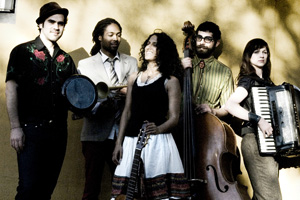
Press Photo by <a href="http://www.flarefilms.co.uk/" target="_blank">Judith Burrows</a>
San Francisco loves Rupa and the April Fishes. The local world-beat ensemble recently garnered a nomination in the alt SF Weekly’s annual music awards, and packed the space with adoring fans at a performance piece I attended last week.
Part of the appeal lies in the group’s personal narrative, which seems designed to bait music editors: Frontwoman Rupa Marya is a physician; their musical influences include gypsy swing, tango, and polka; they sing in Spanish, French, Hindi, and English.
Luckily, their music mostly lives up to the hype. Marya’s vocals are a fine blend of slow-burn passion and buoyant belting, and her backing musicians are highly skilled and perfectly synched.
At the show I witnessed, where the band provided a musical backdrop for acrobats and actors telling the story of illegal immigrants (SF music scene alert!), they lit up the stage. Packed tightly together in all-white garb, they infused their ballads and up-tempo numbers with fervor and grace. When the final song exploded from a slow, sexy tango into an upbeat dance song, the audience couldn’t help but get up and jive along.
Rupa’s recently released CD, Este Mundo doesn’t quite capture this joie de vivre. Some of the group’s best live tropes—escalating tempos, sing-speak vocals—feel suffocated and repetitive on disc. Part of this might just be that their spirited music requires audience interactivity (clapping, dancing, swaying) to really come alive. But I also wish they’d taken more chances in the recording, especially since those they did take were so successful at keeping the music fresh—like a soulful guest rap interlude in “Soledad” and a beautiful classical string section in “L’éléphant.”
Bottom line: If you haven’t heard Rupa and the April Fishes yet, their new CD is a fine place to start. But to truly understand what’s made them musical darlings, best to catch them live.












